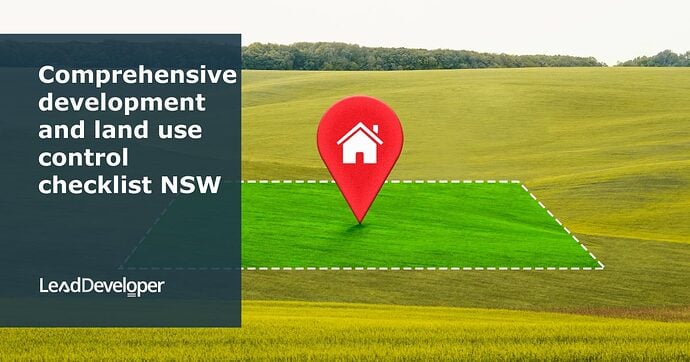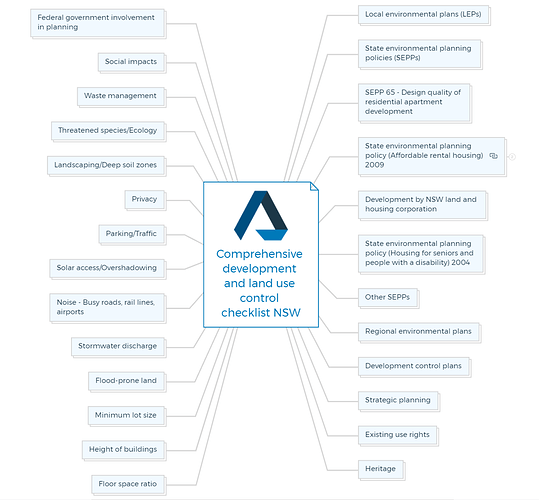Checklist for development and land use control
1. Local environmental plans (LEPs)
- Determine the specific Local Environmental Plan (LEP) applicable to the Council area where the land is located.
- Check if any additional LEPs apply to the parcel of land.
- Review the zoning information in the LEP, including text and maps.
- Identify maximum height controls specified in the LEP.
- Determine the maximum “floor space ratio” controls outlined in the LEP.
- Verify the minimum subdivision lot sizes established by the LEP.
- Check if the land has any local heritage listings in the LEP.
- Identify any site-specific planning controls in the LEP, such as bushfire, flooding, or local character.
2. State environmental planning policies (SEPPs)
- Determine which State Environmental Planning Policies (SEPPs) are applicable to the parcel of land.
- Check if any SEPPs apply specifically to the entire state or to specific areas.
- Identify if there are any SEPPs that exclusively control zoning and land use in the absence of an LEP.
- Assess which SEPPs might be applicable in parallel with an LEP for the proposed development.
- Review the specific provisions and controls outlined in relevant SEPPs.
3. SEPP 65 - Design quality of residential apartment development
- Determine if SEPP 65 applies to the proposed residential flat building development.
- Familiarize yourself with the “design quality principles” specified in SEPP 65.
- Check if the local government area requires the constitution of design quality panels for review.
- Ensure that the Development Application (DA) considers the principles of the “Apartment Design Guide” accompanying SEPP 65.
- Pay particular attention to standards in the Apartment Design Guide related to solar access, private open space, landscaping, cross-ventilation, and other relevant design aspects.
- Understand that SEPP 65 will heavily influence the assessment of the DA by local Councils.
You are missing out if you haven’t yet subscribed to our YouTube channel.
4. State environmental planning policy (Affordable rental housing) 2009
- Determine if the SEPP (Affordable Rental Housing) 2009 applies to the proposed development.
- Understand the options made possible under this policy, including infill affordable housing, secondary dwellings (granny flats), and boarding houses.
- For affordable housing, verify if at least 20% of the floor area will be designated as affordable housing and managed by a registered community housing provider for a minimum of 10 years.
- Assess the bonus in floor space entitlement and reduction in required car parking based on the percentage of affordable housing.
- Be aware of consistent standards for dwelling size, landscaping, solar access, and site eligibility criteria.
- Understand any recent amendments that may have impacted the policy’s effectiveness.
- Note that community housing providers primarily use this policy.
Secondary dwellings (Granny flats)
- Determine if the SEPP allows for the construction of granny flats on the proposed lot in residential areas.
- Check the maximum size limit for granny flats (usually up to 60 square meters).
- Assess whether a private certifier can approve the granny flat to expedite the approval process.
- Be aware of any local requirements or restrictions that may apply in addition to the SEPP.
Boarding houses
- Determine if the SEPP allows for the construction of boarding houses on residentially zoned land.
- Review the standards provided in the SEPP for boarding house developments, including floor space, car parking, private open space, and accommodation size.
- Understand the landscaping, solar access, and facility requirements specified by the SEPP.
- Consider the resurgence in boarding house developments and their recent popularity in Sydney.
- Be aware of any specific criteria or guidelines for boarding house developments.
5. Development by NSW land and housing corporation
- Understand the provision in the SEPP that allows certain development by the NSW Land and Housing Corporation without the need for development consent.
6. State environmental planning policy (Housing for seniors and people with a disability) 2004
- Determine if the Seniors Housing SEPP applies to the proposed development.
- Understand the conditions under which this SEPP allows a developer to potentially override local planning controls.
- Be aware of the focus of this SEPP on housing oriented towards seniors or people with disabilities.
7. Other SEPPs
- State environmental planning policy no 1 - Development standards: Examine how SEPP No 1 affects development standards and variations from standard planning controls.
- State environmental planning policy no 19 - Bushland in urban areas: Understand the restrictions and considerations related to development in areas designated as bushland in urban areas.
- State environmental planning policy no 21 - Caravan parks: Review the regulations governing caravan park developments and their location.
- State environmental planning policy no 33 - Hazardous and offensive development: Learn about the restrictions and considerations related to hazardous and offensive developments.
- State environmental planning policy no 36 - Manufactured home estates: Understand the regulations governing the establishment and management of manufactured home estates.
- State environmental planning policy no 44 - Koala habitat protection: Examine the protections and development restrictions aimed at preserving koala habitats.
- State environmental planning policy no 47 - Moore park showground: Understand the specific planning controls related to Moore Park Showground.
- State environmental planning policy no 50 - Canal estate development: Review the requirements and considerations for developments in canal estate areas.
- State environmental planning policy no 55 - Remediation of land: Learn about the regulations governing land remediation projects.
- State environmental planning policy no 64 - Advertising and signage: Understand the rules and restrictions related to advertising and signage.
- State environmental planning policy no 70 - Affordable housing (Revised schemes): Examine how this SEPP promotes affordable housing.
- State environmental planning policy (Aboriginal land) 2019: Understand the provisions related to development on Aboriginal land.
- State environmental planning policy (Building sustainability index: BASIX) 2004: Review the requirements related to building sustainability.
- State environmental planning policy (Coastal management) 2018: Understand the regulations governing development in coastal areas.
- State environmental planning policy (Concurrences) 2018: Learn about the requirements for concurrences in development applications.
- State environmental planning policy (Educational establishments and child care facilities) 2017: Examine the regulations governing educational and child care facilities.
- State environmental planning policy (Exempt and complying development codes) 2008: Understand the provisions for exempt and complying development.
- State environmental planning policy (Gosford city centre) 2018: Review the planning controls specific to Gosford City Centre.
- State environmental planning policy (Infrastructure) 2007: Learn about the regulations related to infrastructure development.
- State environmental planning policy (Kosciuszko national park-alpine resorts) 2007: Understand the provisions for development within Kosciuszko National Park.
- State environmental planning policy (Kurnell peninsula) 1989: Examine the regulations governing development on the Kurnell Peninsula.
- State environmental planning policy (Mining, petroleum production and extractive industries) 2007: Understand the provisions for mining and extractive industries.
- State environmental planning policy (Miscellaneous consent provisions) 2007: Review miscellaneous consent provisions within this SEPP.
- State environmental planning policy (Penrith lakes scheme) 1989: Learn about the planning controls specific to the Penrith Lakes Scheme.
8. Regional environmental plans
- Determine if there is a Regional Environmental Plan (REP) applicable to the specific region where the development is proposed.
- Review the REP to understand the regional planning controls and environmental considerations that may impact the development.
- Check for any specific zoning or land use designations outlined in the REP.
- Assess any environmental protection measures or restrictions related to threatened species, ecology, or heritage conservation within the region.
9. Development control plans
- Investigate if there are any Development Control Plans (DCPs) associated with the local Council area where the development is located.
- Review the DCP to understand the detailed guidelines, standards, and requirements for development within the area.
- Ensure that the proposed development aligns with the specific provisions outlined in the DCP.
10. Strategic planning
- Research the local or regional strategic planning documents, such as Local Strategic Plans or Regional Growth Plans, to gain insights into long-term development goals and priorities.
- Understand how the proposed development aligns with the broader strategic planning objectives.
11. Existing use rights
- Determine if the proposed development qualifies for existing use rights, which may allow it to continue even if it doesn’t comply with current zoning or land use regulations.
12. Heritage
- Identify any heritage-listed properties or areas near the proposed development site.
- Understand the heritage preservation requirements and restrictions that may apply.
13. Floor space ratio
- Check the applicable floor space ratio (FSR) controls in the local LEP or SEPP to ensure compliance.
14. Height of buildings
- Review the height limits set by the relevant LEP or SEPP for the proposed development.
15. Minimum lot size
- Ensure that the proposed development complies with the minimum lot size requirements outlined in the LEP or SEPP.
16. Flood-prone land
- If the land is in a flood-prone area, assess the flood management provisions and development restrictions that apply.
17. Stormwater discharge
- Understand the stormwater management requirements and discharge regulations for the proposed development.
18. Noise - Busy roads, rail lines, airports
- Consider the potential noise impacts of the proposed development, especially if it is located near busy roads, rail lines, or airports.
19. Solar access/Overshadowing
- Ensure that the development design takes into account solar access and avoids excessive overshadowing of neighboring properties.
20. Parking/Traffic
- Evaluate the parking and traffic requirements and provisions for the proposed development.
21. Privacy
- Address privacy considerations for neighboring properties in the design and layout of the development.
22. Landscaping/Deep soil zones
- Comply with landscaping and deep soil zone requirements to enhance green spaces and environmental sustainability.
23. Threatened species/Ecology
- Assess and address any potential impacts on threatened species or ecological habitats in the vicinity of the development.
24. Waste management
- Plan for proper waste management facilities and procedures as required by local regulations.
25. Social impacts
- Consider and mitigate potential social impacts of the development on the local community.
26. Federal government involvement in planning
- Check if the proposed development involves federal government agencies or federally owned land.
- Understand the specific regulations or approvals required from federal authorities.
- Comply with federal environmental laws and regulations, if applicable.
- Be aware of any consultation or coordination required with federal agencies in the planning and approval process.
- Assess the potential impact of federal policies or initiatives on the proposed development.



